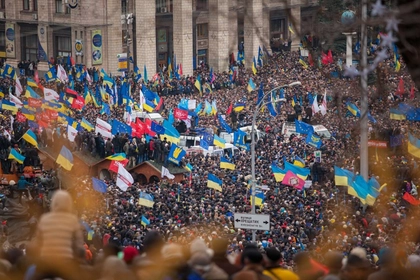For decades the conventional wisdom among military strategists has been that artillery was the king of the battlefield. It was only threatened by the counterbattery capability of the enemy’s guns. If your guns outnumbered or outranged those of the opposition, if you sited them correctly, and had a good strategy – then you would prevail.
The artillery of the 20th century came in two main forms towed and, mostly tracked and armored self-propelled howitzers.
JOIN US ON TELEGRAM
Follow our coverage of the war on the @Kyivpost_official.
The appearance of truck-mounted guns like France’s Caesar were seen as an interesting but inferior hybrid of the two. While they generally allowed the guns to be redeployed faster than their towed cousins, experts thought that they lacked the cross-country capability offered by tracks and were, therefore, more vulnerable.
The war in Ukraine has seen loitering munitions, precision-guided weapons, and most particularly drones, being the catalyst for a change in the balance of the artillery equation.
Artillery is still and probably always will be an indispensable weapon on the battlefield but now, even more than ever, speed in deployment, rapid firing and moving on will be the key to survivability – what the military calls: “shoot and scoot.”
An article in the US military issues magazine Defense One says that the Ukrainian experience, where wheeled guns have proved so effective, has impacted on US army plans for the future modernization of its artillery systems.

Tsikhanouskaya Honors Ukraine’s Day of Dignity and Freedom
It cites Gen. James Rainey, the chief of the US Army Futures Command telling a Senate hearing in May that “… there are some very good, wheeled howitzers that are having great effect in a place like Europe,” in reference to what was happening in Ukraine.
His views contrast to the US' previous preference for tracked self-propelled artillery. In 2021 during a competition to select mobile artillery support for its Stryker Brigades, it rejected the foreign wheeled offerings in favor of the M109 Paladin self-propelled howitzer.
Rainey said that on the future battlefield, artillery systems must be constantly on the move to avoid being detected, identified and destroyed. He said that, in addition, the US was also examining ways of improving and extending the range of mortar systems to supplement that need.
Ukraine’s experience has shown the utility of wheeled howitzers, including Sweden’s FH77BW L52 Archer, France’s Caesar, Ukraine’s own 2S22 Bohdana, compete favorably with tracked guns in terms of firepower, rate of fire, precision and range.
Ukraine recently announced it has expanded its production of Bohdanas to 10 systems a month.
While wheeled guns may not be as mobile off-road as tracked artillery there are sufficient trails and roads in Ukraine (and Europe) that combined with all-wheel drive makes that less of a disadvantage than once thought. Wheeled guns are generally much cheaper, easier to maintain, and modern armor technologies offer protection comparable with most tracked vehicles.
In 2023 the unit cost of the French Caesar MkII was €3.2 million ($3.5 million), compared with Germany’s tracked Panzerhaubitze 2000s was €18.4 million ($20 million) apiece, according to Defense News. It also says that studies have shown that the cost of operating and maintaining wheeled systems can result in cost savings of roughly 30 percent.
Defense News points out that not only the US but others including the UK and Germany, have taken the decision to invest in wheeled howitzers – a direct result of the Ukrainian experience. It cites a spokesperson for Israel’s Elbit Systems, which makes the Atmos truck-mounted howitzer saying that there has been “an uptick in the focus on wheeled, self-propelled howitzers as the war in Ukraine has highlighted a ‘critical need’ for improved mobility.”
Systems such as the Atmos can pull into position, fire multiple rounds and race off in a matter of minutes. The Finnish newspaper Aamulehti reported in April that Helsinki’s Patria Group was developing a truck-mounted version of its 155K98 155mm towed artillery piece following its own assessment of lessons learned in Ukraine.
Russian milbloggers say that Caesar is feared by Russian troops, particularly in the counter-battery role where its superior range, accuracy, mobility, and agility doesn’t give Russian forces enough time to locate and target the Ukrainian weapons and has killed many Russian artillery crews.
The modern, European wheeled systems being used in Ukraine with their 155mm, 52-caliber barrels have a range of about 40 kilometers (25 miles) which is more than the older US towed M777 and tracked Paladin howitzers, as well as most Russian tube artillery. It is drones that pose the biggest threat to Ukrainian gun crews, making the combination of hiding from sight before deploying as well as being mobile, agile and able to rapidly move on from the firing point the key to surviving.
Defense News says that the Eurosatory defense and security exhibition will feature at least 10 artillery makers this year with howitzers and rocket artillery being major draws. This will include the M142 High Mobility Artillery Rocket System (HIMARS) as well as the latest versions of Caesar six and eight-wheeled variations. Elbit says it planned to showcase its PULS multiple-rocket launcher and Sigma next-generation howitzer, both wheeled, before being banned from attending.
Even Russia has bucked its usual tradition of relying on tracked self-propelled artillery with Rostec, the state-owned arms conglomerate, revealing the Malva wheeled howitzer last year.
According to Spencer Jones, a senior lecturer in war studies at the UK’s University of Wolverhampton, the use of wheeled artillery was initially forced on Ukraine as a function of weapons availability rather than a tactical or doctrinal choice.
It may be a happy accident, but in a battlefield where intense counter-battery fire supported by drones and other smart weapons became the order of the day the use by Ukraine of “shoot-and-scoot artillery fire” may well be ushering in a new era of highly mobile howitzers for which these wheeled guns are eminently suited.
You can also highlight the text and press Ctrl + Enter






